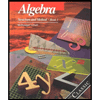
Student Solutions Manual For Ewen/nelson's Elementary Technical Mathematics, 11th
11th Edition
ISBN: 9781285199276
Author: Dale Ewen
Publisher: Cengage Learning
expand_more
expand_more
format_list_bulleted
Concept explainers
Question
Chapter 16.9, Problem 41E
To determine
To calculate: The binary form of the hexadecimal number 4A3B.
Expert Solution & Answer
Want to see the full answer?
Check out a sample textbook solution
Students have asked these similar questions
y = 7.4e-0.5v sin (1.2v)
the value of v where y = 0 for v between 0 and 2π. Using bisection method and newton-
Raphson method.
[2
01
3. (12 pts) Let A =
1
1 and b = 1
L2
1]
213
[2]
(1)
(2)
Use the Gram-Schmidt process to find an orthonormal basis for the column
space of A.
Factor A into a product QR, where Q has an orthonormal set of column
vectors and R is upper triangular.
(3) Solve the least squares problem Ax = b.
A person is interested in constructing a portfolio. Two stocks are being considered. Let
x percent return for an investment in stock 1, and y = percent return for an investment in
stock 2. The expected return and variance for stock 1 are E(x) = 8.45% and Var(x) = 25.
The expected return and variance for stock 2 are E(y) = 3.20% and Var(y) = 1. The
covariance between the returns is σ = −3.
a. What is the standard deviation for an investment in stock 1 and for an investment in
stock 2? Using the standard deviation as a measure of risk, which of these stocks is
the riskier investment?
b. What is the expected return and standard deviation, in dollars, for a person who invests
$500 in stock 1?
C.
What is the expected percent return and standard deviation for a person who constructs
a portfolio by investing 50% in each stock?
d. What is the expected percent return and standard deviation for a person who constructs
a portfolio by investing 70% in stock 1 and 30% in stock 2?
e. Compute the…
Chapter 16 Solutions
Student Solutions Manual For Ewen/nelson's Elementary Technical Mathematics, 11th
Ch. 16.1 - Change each binary number to decimal form: 11Ch. 16.1 - Prob. 2ECh. 16.1 - Prob. 3ECh. 16.1 - Prob. 4ECh. 16.1 - Prob. 5ECh. 16.1 - Prob. 6ECh. 16.1 - Prob. 7ECh. 16.1 - Prob. 8ECh. 16.1 - Prob. 9ECh. 16.1 - Prob. 10E
Ch. 16.1 - Prob. 11ECh. 16.1 - Prob. 12ECh. 16.1 - Prob. 13ECh. 16.1 - Prob. 14ECh. 16.1 - Prob. 15ECh. 16.1 - Prob. 16ECh. 16.1 - Change each binary number to decimal form:...Ch. 16.1 - Prob. 18ECh. 16.1 - Change each binary number to decimal form: 111111Ch. 16.1 - Prob. 20ECh. 16.2 - Prob. 1ECh. 16.2 - Prob. 2ECh. 16.2 - Prob. 3ECh. 16.2 - Prob. 4ECh. 16.2 - Prob. 5ECh. 16.2 - Prob. 6ECh. 16.2 - Prob. 7ECh. 16.2 - Prob. 8ECh. 16.2 - Prob. 9ECh. 16.2 - Prob. 10ECh. 16.2 - Prob. 11ECh. 16.2 - Prob. 12ECh. 16.2 - Prob. 13ECh. 16.2 - Prob. 14ECh. 16.2 - Prob. 15ECh. 16.2 - Add the following binary numbers and check your...Ch. 16.2 - Prob. 17ECh. 16.2 - Prob. 18ECh. 16.2 - Prob. 19ECh. 16.2 - Prob. 20ECh. 16.2 - Prob. 21ECh. 16.2 - Prob. 22ECh. 16.2 - Prob. 23ECh. 16.2 - Add the following binary numbers and check your...Ch. 16.2 - Prob. 25ECh. 16.2 - Prob. 26ECh. 16.2 - Add the following binary numbers and check your...Ch. 16.2 - Prob. 28ECh. 16.2 - Prob. 29ECh. 16.2 - Prob. 30ECh. 16.3 - Prob. 1ECh. 16.3 - Prob. 2ECh. 16.3 - Subtract the following binary numbers and check in...Ch. 16.3 - Prob. 4ECh. 16.3 - Subtract the following binary numbers and check in...Ch. 16.3 - Subtract the following binary numbers and check in...Ch. 16.3 - Prob. 7ECh. 16.3 - Prob. 8ECh. 16.3 - Prob. 9ECh. 16.3 - Subtract the following binary numbers and check in...Ch. 16.3 - Subtract the following binary numbers and check in...Ch. 16.3 - Prob. 12ECh. 16.3 - Prob. 13ECh. 16.3 - Prob. 14ECh. 16.3 - Subtract the following binary numbers and check in...Ch. 16.3 - Prob. 16ECh. 16.3 - Prob. 17ECh. 16.3 - Subtract the following binary numbers and check in...Ch. 16.3 - Prob. 19ECh. 16.3 - Prob. 20ECh. 16.3 - Prob. 21ECh. 16.3 - Prob. 22ECh. 16.3 - Prob. 23ECh. 16.3 - Prob. 24ECh. 16.3 - Prob. 25ECh. 16.3 - Prob. 26ECh. 16.3 - Prob. 27ECh. 16.3 - Prob. 28ECh. 16.3 - Prob. 29ECh. 16.3 - Use the 1s complement method to subtract the...Ch. 16.3 - Prob. 31ECh. 16.3 - Prob. 32ECh. 16.3 - Prob. 33ECh. 16.3 - Prob. 34ECh. 16.3 - Prob. 35ECh. 16.3 - Prob. 36ECh. 16.4 - Prob. 1ECh. 16.4 - Prob. 2ECh. 16.4 - Multiply the following binary numbers: 11010_Ch. 16.4 - Prob. 4ECh. 16.4 - Prob. 5ECh. 16.4 - Prob. 6ECh. 16.4 - Prob. 7ECh. 16.4 - Prob. 8ECh. 16.4 - Prob. 9ECh. 16.4 - Prob. 10ECh. 16.4 - Prob. 11ECh. 16.4 - Prob. 12ECh. 16.4 - Prob. 13ECh. 16.4 - Multiply the following binary numbers: 101101101_Ch. 16.4 - Prob. 15ECh. 16.4 - Prob. 16ECh. 16.4 - Prob. 17ECh. 16.4 - Prob. 18ECh. 16.4 - Prob. 19ECh. 16.4 - Prob. 20ECh. 16.5 - Prob. 1ECh. 16.5 - Prob. 2ECh. 16.5 - Prob. 3ECh. 16.5 - Prob. 4ECh. 16.5 - Prob. 5ECh. 16.5 - Prob. 6ECh. 16.5 - Prob. 7ECh. 16.5 - Prob. 8ECh. 16.5 - Prob. 9ECh. 16.5 - Prob. 10ECh. 16.5 - Prob. 11ECh. 16.5 - Prob. 12ECh. 16.5 - Prob. 13ECh. 16.5 - Prob. 14ECh. 16.5 - Prob. 15ECh. 16.5 - Prob. 16ECh. 16.5 - Prob. 17ECh. 16.5 - Prob. 18ECh. 16.5 - Prob. 19ECh. 16.5 - Prob. 20ECh. 16.6 - Prob. 1ECh. 16.6 - Prob. 2ECh. 16.6 - Prob. 3ECh. 16.6 - Prob. 4ECh. 16.6 - Prob. 5ECh. 16.6 - Prob. 6ECh. 16.6 - Prob. 7ECh. 16.6 - Prob. 8ECh. 16.6 - Prob. 9ECh. 16.6 - Prob. 10ECh. 16.6 - Prob. 11ECh. 16.6 - Prob. 12ECh. 16.6 - Prob. 13ECh. 16.6 - Prob. 14ECh. 16.6 - Prob. 15ECh. 16.6 - Prob. 16ECh. 16.6 - Prob. 17ECh. 16.6 - Prob. 18ECh. 16.6 - Prob. 19ECh. 16.6 - Change each binary number to decimal form:...Ch. 16.7 - Prob. 1ECh. 16.7 - Prob. 2ECh. 16.7 - Prob. 3ECh. 16.7 - Prob. 4ECh. 16.7 - Prob. 5ECh. 16.7 - Prob. 6ECh. 16.7 - Prob. 7ECh. 16.7 - Prob. 8ECh. 16.7 - Prob. 9ECh. 16.7 - Prob. 10ECh. 16.7 - Prob. 11ECh. 16.7 - Prob. 12ECh. 16.7 - Prob. 13ECh. 16.7 - Change each hexadecimal number to decimal form:...Ch. 16.7 - Prob. 15ECh. 16.7 - Prob. 16ECh. 16.7 - Prob. 17ECh. 16.7 - Prob. 18ECh. 16.7 - Prob. 19ECh. 16.7 - Prob. 20ECh. 16.7 - Prob. 21ECh. 16.7 - Prob. 22ECh. 16.7 - Prob. 23ECh. 16.7 - Prob. 24ECh. 16.7 - Prob. 25ECh. 16.7 - Prob. 26ECh. 16.7 - Prob. 27ECh. 16.7 - Prob. 28ECh. 16.7 - Prob. 29ECh. 16.7 - Prob. 30ECh. 16.8 - Prob. 1ECh. 16.8 - Prob. 2ECh. 16.8 - Prob. 3ECh. 16.8 - Prob. 4ECh. 16.8 - Prob. 5ECh. 16.8 - Prob. 6ECh. 16.8 - Prob. 7ECh. 16.8 - Prob. 8ECh. 16.8 - Prob. 9ECh. 16.8 - Prob. 10ECh. 16.8 - Prob. 11ECh. 16.8 - Prob. 12ECh. 16.8 - Prob. 13ECh. 16.8 - Prob. 14ECh. 16.8 - Prob. 15ECh. 16.8 - Prob. 16ECh. 16.8 - Prob. 17ECh. 16.8 - Prob. 18ECh. 16.8 - Prob. 19ECh. 16.8 - Prob. 20ECh. 16.8 - Prob. 21ECh. 16.8 - Prob. 22ECh. 16.8 - Prob. 23ECh. 16.8 - Prob. 24ECh. 16.8 - Prob. 25ECh. 16.8 - Prob. 26ECh. 16.8 - Add the following hexadecimal numbers. Check using...Ch. 16.8 - Prob. 28ECh. 16.8 - Prob. 29ECh. 16.8 - Prob. 30ECh. 16.8 - Prob. 31ECh. 16.8 - Prob. 32ECh. 16.8 - Prob. 33ECh. 16.8 - Prob. 34ECh. 16.8 - Prob. 35ECh. 16.8 - Prob. 36ECh. 16.8 - Prob. 37ECh. 16.8 - Prob. 38ECh. 16.8 - Prob. 39ECh. 16.8 - Prob. 40ECh. 16.8 - Prob. 41ECh. 16.8 - Prob. 42ECh. 16.8 - Prob. 43ECh. 16.8 - Prob. 44ECh. 16.8 - Prob. 45ECh. 16.8 - Prob. 46ECh. 16.8 - Prob. 47ECh. 16.8 - Prob. 48ECh. 16.8 - Prob. 49ECh. 16.8 - Prob. 50ECh. 16.8 - Prob. 51ECh. 16.8 - Prob. 52ECh. 16.8 - Prob. 53ECh. 16.8 - Prob. 54ECh. 16.8 - Prob. 55ECh. 16.8 - Prob. 56ECh. 16.8 - Prob. 57ECh. 16.8 - Prob. 58ECh. 16.8 - Prob. 59ECh. 16.8 - Prob. 60ECh. 16.9 - Prob. 1ECh. 16.9 - Prob. 2ECh. 16.9 - Prob. 3ECh. 16.9 - Prob. 4ECh. 16.9 - Prob. 5ECh. 16.9 - Prob. 6ECh. 16.9 - Prob. 7ECh. 16.9 - Prob. 8ECh. 16.9 - Prob. 9ECh. 16.9 - Prob. 10ECh. 16.9 - Prob. 11ECh. 16.9 - Prob. 12ECh. 16.9 - Prob. 13ECh. 16.9 - Prob. 14ECh. 16.9 - Prob. 15ECh. 16.9 - Prob. 16ECh. 16.9 - Prob. 17ECh. 16.9 - Prob. 18ECh. 16.9 - Prob. 19ECh. 16.9 - Prob. 20ECh. 16.9 - Prob. 21ECh. 16.9 - Prob. 22ECh. 16.9 - Prob. 23ECh. 16.9 - Change each binary number to hexadecimal form:...Ch. 16.9 - Prob. 25ECh. 16.9 - Prob. 26ECh. 16.9 - Prob. 27ECh. 16.9 - Prob. 28ECh. 16.9 - Prob. 29ECh. 16.9 - Prob. 30ECh. 16.9 - Prob. 31ECh. 16.9 - Prob. 32ECh. 16.9 - Prob. 33ECh. 16.9 - Prob. 34ECh. 16.9 - Prob. 35ECh. 16.9 - Prob. 36ECh. 16.9 - Prob. 37ECh. 16.9 - Prob. 38ECh. 16.9 - Prob. 39ECh. 16.9 - Prob. 40ECh. 16.9 - Prob. 41ECh. 16.9 - Prob. 42ECh. 16.9 - Prob. 43ECh. 16.9 - Prob. 44ECh. 16 - Prob. 1RCh. 16 - Prob. 2RCh. 16 - Prob. 3RCh. 16 - Prob. 4RCh. 16 - Prob. 5RCh. 16 - Prob. 6RCh. 16 - Add the following binary numbers: 1001110101_Ch. 16 - Prob. 8RCh. 16 - Prob. 9RCh. 16 - Prob. 10RCh. 16 - Prob. 11RCh. 16 - Prob. 12RCh. 16 - Prob. 13RCh. 16 - Prob. 14RCh. 16 - Prob. 15RCh. 16 - Prob. 16RCh. 16 - Prob. 17RCh. 16 - Prob. 18RCh. 16 - Prob. 19RCh. 16 - Prob. 20RCh. 16 - Prob. 21RCh. 16 - Prob. 22RCh. 16 - Prob. 23RCh. 16 - Prob. 24RCh. 16 - Prob. 25RCh. 16 - Prob. 26RCh. 16 - Prob. 27RCh. 16 - Prob. 28RCh. 16 - Prob. 29RCh. 16 - Prob. 30RCh. 16 - Prob. 1TCh. 16 - Prob. 2TCh. 16 - Prob. 3TCh. 16 - Prob. 4TCh. 16 - Prob. 5TCh. 16 - Prob. 6TCh. 16 - Prob. 7TCh. 16 - Prob. 8TCh. 16 - Prob. 9TCh. 16 - Prob. 10TCh. 16 - Prob. 11TCh. 16 - Prob. 12TCh. 16 - Prob. 13TCh. 16 - Prob. 14TCh. 16 - Prob. 15TCh. 16 - Prob. 16TCh. 16 - Prob. 17TCh. 16 - Prob. 18TCh. 16 - Prob. 19TCh. 16 - Prob. 20TCh. 16 - Prob. 1CRCh. 16 - Prob. 2CRCh. 16 - Prob. 3CRCh. 16 - Prob. 4CRCh. 16 - Prob. 5CRCh. 16 - Prob. 6CRCh. 16 - Prob. 7CRCh. 16 - Prob. 8CRCh. 16 - Prob. 9CRCh. 16 - Prob. 10CRCh. 16 - Prob. 11CRCh. 16 - Prob. 12CRCh. 16 - Prob. 13CRCh. 16 - Prob. 14CRCh. 16 - Prob. 15CRCh. 16 - Prob. 16CRCh. 16 - Prob. 17CRCh. 16 - Prob. 18CRCh. 16 - Prob. 19CRCh. 16 - Prob. 20CRCh. 16 - Prob. 21CRCh. 16 - Prob. 22CRCh. 16 - Prob. 23CRCh. 16 - Prob. 24CRCh. 16 - Do as indicated for the following binary numbers:...Ch. 16 - Prob. 26CRCh. 16 - Prob. 27CRCh. 16 - Prob. 28CRCh. 16 - Prob. 29CRCh. 16 - Prob. 30CR
Knowledge Booster
Learn more about
Need a deep-dive on the concept behind this application? Look no further. Learn more about this topic, subject and related others by exploring similar questions and additional content below.Similar questions
- Airline passengers arrive randomly and independently at the passenger-screening facility at a major international airport. The mean arrival rate is 10 passengers per minute. a. Compute the probability of no arrivals in a one-minute period. b. Compute the probability that three or fewer passengers arrive in a one-minute period. c. Compute the probability of no arrivals in a 15-second period. d. Compute the probability of at least one arrival in a 15-second period.arrow_forwardMarket-share-analysis company Net Applications monitors and reports on Internet browser usage. According to Net Applications, in the summer of 2014, Google's Chrome browser exceeded a 20% market share for the first time, with a 20.37% share of the browser market (Forbes website, December 15, 2014). For a randomly selected group of 20 Internet browser users, answer the following questions. a. Compute the probability that exactly 8 of the 20 Internet browser users use Chrome as their Internet browser. b. Compute the probability that at least 3 of the 20 Internet browser users use Chrome as their Internet browser. c. For the sample of 20 Internet browser users, compute the expected number of Chrome users. d. For the sample of 20 Internet browser users, compute the variance and standard devia- tion for the number of Chrome users.arrow_forwardAutomobile repair costs continue to rise with the average cost now at $367 per repair (U.S. News & World Report website, January 5, 2015). Assume that the cost for an automobile repair is normally distributed with a standard deviation of $88. Answer the following questions about the cost of automobile repairs. a. What is the probability that the cost will be more than $450? b. What is the probability that the cost will be less than $250? C. What is the probability that the cost will be between $250 and $450? d. If the cost for your car repair is in the lower 5% of automobile repair charges, what is your cost?arrow_forward
- Television viewing reached a new high when the Nielsen Company reported a mean daily viewing time of 8.35 hours per household (USA Today, November 11, 2009). Use a nor- mal probability distribution with a standard deviation of 2.5 hours to answer the following questions about daily television viewing per household. a. What is the probability that a household views television between 5 and 10 hours a day? b. How many hours of television viewing must a household have in order to be in the top 3% of all television viewing households? c. What is the probability that a household views television more than 3 hours a day?arrow_forwardmarrow_forwardGraph a right triangle with the two points forming the hypotenuse. Using the sides, find the distance between the two points, to the nearest tenth (if necessary). left parenthesis, 4, comma, 1, right parenthesis, and , left parenthesis, minus, 5, comma, minus, 6, right parenthesis (4,1) and (−5,−6)arrow_forward
- 22.) Mr. Vedrani has a pool with a deck built around it. The equation (2x+14)(2x+19) = 650 represents the relationship of the side lengths (in feet) of the entire pool area (in square feet). a.) If 350 represents the area of the pool and deck area, what do the expressions (2x+14) and (2x+19) each represent? b.) Using graphing technology, find x, the width of the deck around the pool. If necessary, round to the nearest tenth. x=arrow_forwardHow do I get common factors?arrow_forwardgiven x[n], show the graphic for x[2n] x[n]=4delta[n-1]+2delta[n-2]+delta[n-3]arrow_forward
- Problem #1 You apply to two different graduate programs at a specific university: one in geology and one in environmental sciences. Let P(G) = 0.8, where P(G) represents the probability that you get accepted into the geology program. Let P(E) = 0.72, where P(E) represents the probability that you get accepted into the environmental sciences program. Let P(GE) = 0.65. a). Create a Venn diagram that represents this information. b). First, calculate P(GUE). Then, using complete sentence, interpret what P(GUE) represents in the context of this problem.arrow_forwardPlease help me solve thanksarrow_forwardplease help me solvearrow_forward
arrow_back_ios
SEE MORE QUESTIONS
arrow_forward_ios
Recommended textbooks for you
 College Algebra (MindTap Course List)AlgebraISBN:9781305652231Author:R. David Gustafson, Jeff HughesPublisher:Cengage Learning
College Algebra (MindTap Course List)AlgebraISBN:9781305652231Author:R. David Gustafson, Jeff HughesPublisher:Cengage Learning Algebra: Structure And Method, Book 1AlgebraISBN:9780395977224Author:Richard G. Brown, Mary P. Dolciani, Robert H. Sorgenfrey, William L. ColePublisher:McDougal Littell
Algebra: Structure And Method, Book 1AlgebraISBN:9780395977224Author:Richard G. Brown, Mary P. Dolciani, Robert H. Sorgenfrey, William L. ColePublisher:McDougal Littell Mathematics For Machine TechnologyAdvanced MathISBN:9781337798310Author:Peterson, John.Publisher:Cengage Learning,
Mathematics For Machine TechnologyAdvanced MathISBN:9781337798310Author:Peterson, John.Publisher:Cengage Learning,

College Algebra (MindTap Course List)
Algebra
ISBN:9781305652231
Author:R. David Gustafson, Jeff Hughes
Publisher:Cengage Learning

Algebra: Structure And Method, Book 1
Algebra
ISBN:9780395977224
Author:Richard G. Brown, Mary P. Dolciani, Robert H. Sorgenfrey, William L. Cole
Publisher:McDougal Littell

Mathematics For Machine Technology
Advanced Math
ISBN:9781337798310
Author:Peterson, John.
Publisher:Cengage Learning,
ALGEBRAIC EXPRESSIONS & EQUATIONS | GRADE 6; Author: SheenaDoria;https://www.youtube.com/watch?v=fUOdon3y1hU;License: Standard YouTube License, CC-BY
Algebraic Expression And Manipulation For O Level; Author: Maths Solution;https://www.youtube.com/watch?v=MhTyodgnzNM;License: Standard YouTube License, CC-BY
Algebra for Beginners | Basics of Algebra; Author: Geek's Lesson;https://www.youtube.com/watch?v=PVoTRu3p6ug;License: Standard YouTube License, CC-BY
Introduction to Algebra | Algebra for Beginners | Math | LetsTute; Author: Let'stute;https://www.youtube.com/watch?v=VqfeXMinM0U;License: Standard YouTube License, CC-BY